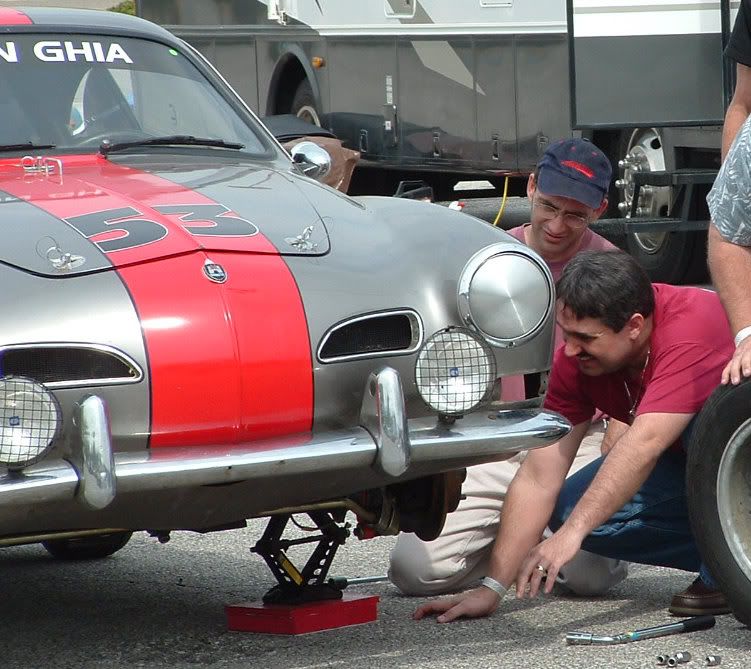All of the books I have seen that discuss the mechanics of gravity center (which is front to rear....through the horizontal/longitudinal axis...not through the vertical/longitudinal axis....which is ROLL center).... ALL dance around the important point of fact that (a) automotive bodies are nowhere near rigid (b) It matters not what your STATIC center of gravity is when in motion because it is acted upon and changed by enertia.
(c) You must calculate in (and they can't...too many variables to make universal rules)....what happens when various parts of the suspension MOVE...or flex...allowing parts of the body or suspension to be lifted out of plane with reference to forward movement. This flex can be initiated by braking, gear changes or turning (centrifugal forces).
There is no mystery here. It simple.
You can do this with a model of a car just like a real one. Get a rod...balance the car model on it. Move the rod forward smoothly....while holding the car until they are up to equal speed. Keep moving the rod and let go of the car. The car will fall off.
Enertia will ALWAYS cause the car to fall off of the rod toward the rear...even if you did this in a vacuum.
Now...reposition the rod slighlty rearward of the original calculated ceenter of balance and start over.
You will now find that ENERTIALLY....while in MOTION...the car has an altered center of gravity . It will now balance and stay on the rod at a constant speed. You will have the same effect only opposite when doing this trick while decelerating from forward motion. it will require selecting a new balance point FORWARD of where the static center of gravity was found to be.
Wait....one might point out that the car on the balance beam...is different because there is no ground underneath to keep the car from tipping forward or back and falling off the rod so this does not count.
Wrong.
Because on the real car...that forward enertia from either forward movment or braking....causes compression and changes in alignment to flexible or pivoting suspension components. These change the alignment of the suspension.....and related axes and angle of attack to the body or chassis. It changes the entire attitude of the car, in the process it changes all of your points of balance through enertia.
This is from front to back and has absolutely nothing in this world to do with the cars CG in reference to its height or lowering.
Upon slowing the rod dow...the car tips foward...always. Enertia tipped forward. The center of ENERTIAL balance has changed again.
The thing you cannot see from this simple experiment is that YES...you also have a lateral center of gravity....which is really the ROLL CENTER....AND IS NOT THE CG...for the vehicle.
I beleive this is the point you were trying to make. You are speaking of ROLL CENTER....not CG . Forward and backward enertias themselves will have no effect on where the actual roll center is on a vehicle is. Yes RC has to do with height in relation to axle center. That dimension is not changed by front to rear enertia change.
However...RC acts as a multiplier upon enertial changes during combinations of forward motion and lateral motion combined (cornering) or braking and lateral motion. Even in straight line motion and braking you get some effect and multiplication of RC...because of lifting and diving due to enertia. The roll center will be different from front to rear in that case.....and will be different in effect depending upon what volume of MASS is located in those two different locations.
You also have a varying diagonal center of balance that is acted upon by BOTH the ROLL CENTER (what you guys are calling CG...which are not the same thing)....AND the front and back enertial balance point (which shifts during accel and decel and IS the TRUE CG).
That diagonal shift rears its head when you are applying lateral force (turning or skidpad/centrifugal)as well as forward acceleration (shifting enertia to the rear)...and also when you apply braking or deceleration forces (enertia shift to front) as well as lateral (turning/skidpad/centrifugal).
In this last case....you get movement in THREE axis on the body at one time.
The wildcards most suspension "theory" books don't talk about is that they have no idea how a given suspension is tuned...is it stiff...is it soft?, what type it is going to be, what your weight is, where the main points of mass in the car are to be situated (front engine/mid engine/rear engine...wheres the fuel tank?), high soft side walls, low stiff side walls.....or even wether you are running four wheel independent versus a solid axle.... etc, etc, etc, etc.
The move from asolid rear axle to four wheel independent alone....give a radical change to roll center, gravity center/balance and enertial changes to a vehicle. Just look at the changes from swing to IRS!
In this arena...I have seen no real overridingly credible engineering treatise. Its usually just some race driver or car manufacturing engineers personal opinion based on their own experience (and those are good). I deal with too many engineers already

. Stick with the physics of motion and you can analyze your own vehcile movement patterns.
Seriously....you do know that there are at LEAST three main axes of force that work within a body or car chassis in motion don't you? ....not even including all of the potenetital variations and permutations from suspension, tires, stiffness, tuning or even whether the ground is even level. Ray

